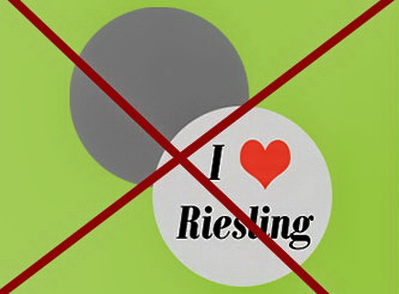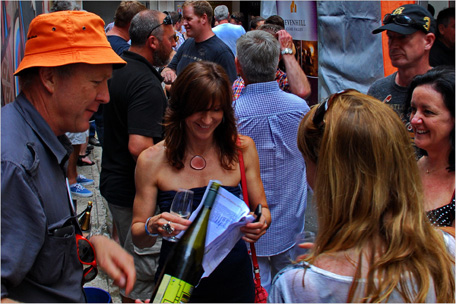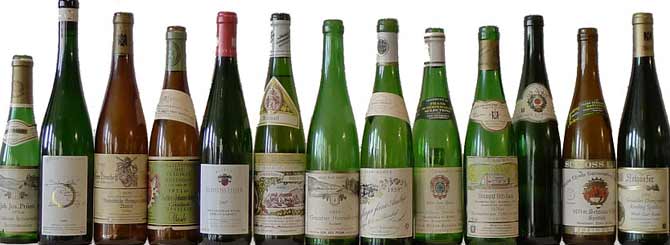‘RIESLING is set to be the white wine of choice this summer’
So says Max Allen in the Australian and adds ‘at least it will be if Australia’s winemakers, retailers, event organisers and sommeliers have their way.’ Then Max admits that the ‘classic white grape still suffers from an image problem for some wine drinkers: ‘consumers weaned on Chardonnay and Sauvignon Blanc often think Riesling is going to taste sweet, so avoid trying it.’
If consumers don’t know what to expect from a given product, the obvious culprit is Marketing or lack of it. The unpopularity of Riesling has resulted in a top quality wine that mostly sells for less than $20. Riesling is racy, crisp and stylish. Riesling has purity and precision in abundance; Riesling is a great food wine yet easy to enjoy on its own; Riesling repays cellaring more reliably than most wines. Riesling is also the best wine value for money, so why is it so hard to get consumers excited about it?
‘It’s simply a Myth’
It’s the same overseas: Scores of wine writers have been predicting Riesling’s return to popularity for years, and been proven wrong. In a wine-searcher piece, Wink Lorch cites leading wine writers like Jancis Robinson in the UK and David Schildknecht in the USA who’ve been beating the drum for Riesling and adds: ‘I swear that New Year forecasts from 1995 onwards – that’s 20 years, folks – have insisted that Riesling will have its day of glory again.
Has it? No. Will it? No. It’s simply a myth that wine drinkers will shun something more simplistic like buttery Chardonnay, pungent Sauvignon Blanc or bland Pinot Grigio for the ultimate in white-wine complexity, kerosene flavours included.’
How did Riesling become so unpopular?
Germany is the cradle of Riesling. In the 19th Century, German ‘Hock’ rivalled the top Bordeaux reds in popularity and price. German Rieslings were popular once more in the twentieth century, in the 1960s and ’70s. Experts blame the Austrian wine scandal of the mid-eighties for the fall of Riesling – some Austrian winemakers added antifreeze to their unripe Rieslings to make them smoother. A marketing masterstroke.
In Australia, Riesling’s image was confused from the beginning: until the early seventies, we had 3 very different kinds of Riesling: Hunter River Riesling (Semillon), Clare Riesling (Crouchen) and Rhine Riesling (the real thing). Riesling suffered from an identity crisis and an image problem. Some of our Riesling makers also bastardised the style by adding sweet Traminer or retaining some sugar.
The Marketing of Riesling has been a Disaster
Consumers have no idea what to expect from Aussie Riesling. The Kiwis have shown us how to market a wine style: you can accuse them of bastardising Sauvignon Blanc but their commercial style is consistent, so consumers know what they’re getting. The folks marketing our Rieslings haven’t learnt that lesson.
‘It’s such a versatile grape that produces so many different styles of super-refreshing wine,’ sommelier Jacquie Lewis, the organiser of the Summer of Riesling festival, tells Max Allen. ‘I really feel there’s a need to bang the drum about this diversity with consumers. And there’s no better way to do it than in an informal, relaxed tasting environment where people can interact with the winemaker.’
Jacquie, I agree with what you about Rieslings terrific diversity but, if we want to win over more consumers, we need to clearly define the style long before we talk about diversity. If we start with Riesling’s great diversity, we’ll just confuse them.
Stop marketing to the converted
A 5% growth year on year (from a pretty small base) has given Riesling champions fresh hope, but it simply indicates that the Riesling lovers out there are buying a little more of it because it’s such terrific value. It does not mean that ‘consumers have already switched on to the variety …’ They haven’t.
Clare Valley winemaker Kerri Thompson tells Max Allen: ‘I’m seeing a whole new wave of young professionals taking a really keen interest in my wines … and mostly it’s because they’ve been introduced to the grape at events like Summer of Riesling or Riesling Downunder that present Riesling in a social, popular way.’
 I suspect those young professionals are serious wine lovers, given the the $800 dollar charge for the 3-day Riesling Downunder Fest. Clearly this event is designed for serious wine buffs and tradies, but even the more modest Summer of Riesling affair is aimed at people who’re knowledgable about wine already. It’s not encouraging consumers to try a new wine style.
I suspect those young professionals are serious wine lovers, given the the $800 dollar charge for the 3-day Riesling Downunder Fest. Clearly this event is designed for serious wine buffs and tradies, but even the more modest Summer of Riesling affair is aimed at people who’re knowledgable about wine already. It’s not encouraging consumers to try a new wine style.
Broaden the market
The real challenge is to introduce a broader audience to the pleasures of Riesling, and that means marketing to the not-converted: wine drinkers who’re blissfully unaware of Riesling’s many charms. The question is: how do we wean them off their lolly water Kiwi savvies? Here are a few options:
- Launch a Riesling Revolution campaign in the media
- Promote Riesling as a cool, smart wine in the lifestyle magazines
- Promote Riesling as a great food wine in the food magazines
- Hand out Riesling and chicken wings at street fairs and community events
Riesling and chicken wings? Yes! Last year, I wrote a post headed Australia is Blessed with the Unpopularity of Riesling, which made a simple point: The reason more people don’t drink Riesling is that wine and food writers tell them to drink it with the wrong foods – seafood, cold salads, sashimi, stuffed capsicum, eggplant and more.
No wonder consumers are confused: they don’t know what to expect from a bottle of Riesling, and they drink it with the wrong foods. Roast chicken and Riesling are made for each other, and how many people eat roast chicken? Loads, and often. Many grab it on the way home, already cooked. We have to make them grab a bottle of Riesling to go with it, and that comes back to marketing.
Sell the style
Riesling has a lot going for it, and I’ve never seen the benefits stated in a way that makes punters think: I really want to try that.
- Riesling is crisp, racy, zippy, refreshing, not heavy and not oaked
- Riesling has terrific flavour – limes and minerals when young, honey and buttered toast when older
- Young Riesling makes a great aperitif or anytime drink
- Riesling is a great summer picnic wine
- Riesling is low in alcohol – 12% on average
- Riesling is a smart wine for smart people
- Riesling is great value for money
Clearly Riesling has a lot to offer, and well-targeted marketing can to convey that to the broader wine drinking public. It’s a matter of clear messaging and consistency, and taking the product to consumers.
Kim

